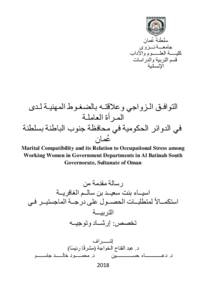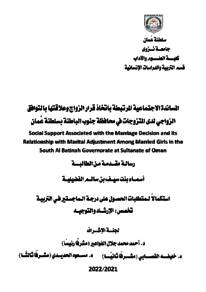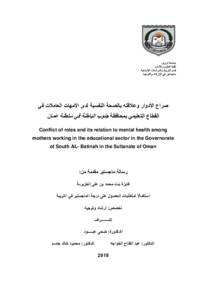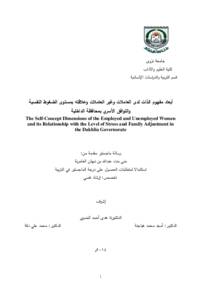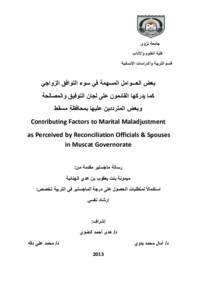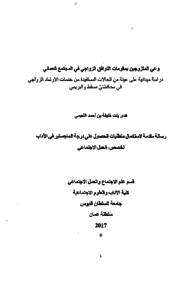Document
التوافق الزواجي وعلاقته بالضغوط المهنية لدى المرأة العاملة في الدوائر الحكومية في محافظة جنوب الباطنة بسلطنة عمان.
Publisher
جامعة نزوى
Gregorian
2018
Language
Arabic
Subject
English abstract
The study aimed to identify the relation between the marital compatibility and occupational stress among working women in Government Departments in Al Batinah South Governorate, Sultanate of Oman. This study was conducted on 150 working women (i.e. 4.1% of the original study population). The researcher used the Dyadic Adjustment Scale (DAS; Spanier, 1976) translated by (Frisa, 2013) and the Occupational Stress Scale (Al-Ghadaniyah, 2011), adopting The correlative descriptive approach was adopted in the study. The study indicated that the level of marital compatibility among working women was high according to the following dimensions: the consensus between a couple was the highest one with an average of (2.76), emotion expression came with an average of (2.70), harmony average was (2.26), and satisfaction average was (1.69). While the average level of occupational stress among working women was low. The dimension of supervision stress was the highest average one with (4.01); coworkers stress average was (3.97); working hours stress average was (3.90); management stress average was (3.76); convenience, change and professional growth stresses average was (3.70); the average of job nature stress was (3.58); and finally the financial stress average was (3.41). The results also showed a statistically significant reverse correlation at (α ≥ 0.01) between the marital compatibility and the occupational stress. Thus, the more the marital compatibility increases, the more the occupational stress decreases and vice versa among working women. In addition, the marital compatibility was predictor of the occupational stress level, since it explained about 13% of the variance in the occupational stress.
Member of
Resource URL
Arabic abstract
هدفت هذه الدراسة التعرف إلى التوافق الزواجي وعلاقته بالضغوط المهنية لدى المرأة العاملة في الدوائر الحكومية في محافظة جنوب الباطنة بسلطنة عُمان، وبلغ عدد أفراد العينة (150) امرأة عاملة، أي بنسبة (28%) من مجتمع الدراسة الأصلي، وتم استخدام مقياس التوافق الزواجي من إعداد سبينر(Spanier,1976)، وترجمته فريزة (2013)، ومقياس الضغوط المهنية من إعداد الغدانية (2011)، واتبعت الدراسة المنهج الوصفي الارتباطي، وتوصلت إلى أن مستوى التوافق الزواجي لدى المرأة العاملة كان مرتفعًا، حيث حصل بُعد الإجماع بين الطرفين على أعلى المتوسطات بمتوسط (2,76)، ثم جاء بُعد التعبير عن العواطف بمتوسط بلغ (2,70)، يليه بُعد الانسجام بين الطرفين بمتوسط (2,26)، وأخيراَ بُعد الرضا بين الطرفين بمتوسط (1,69)، بينما مستوى الضغوط المهنية لدى المرأة العاملة كان منخفضًا، حيث حصل بُعد ضغوط الإشراف على أعلى المتوسطات بمتوسط (4,01)، ثم بُعد ضغوط الزملاء بمتوسط بلغ (3,97) ، ثم جاء بُعد ضغوط مواعيد العمل بمتوسط بلغ (3,90)، ويليه بُعد ضغوط الإدارة بمتوسط (3,76)، ثم جاء بُعد ضغوط المواءمة والتغير والنمو المهني بمتوسط بلغ (3,70)، أما قبل الاخيرة جاءت ضغوط طبيعة المهنة بمتوسط (3,58)، وأخيرًا بُعد ضغوط المادية بمتوسط (3,41)، كما أظهرت النتائج وجود علاقة ارتباطية عكسية ذات دلالة إحصائية عند مستوى بين التوافق الزواجي والضغوط المهنية، أي بمعنى كلما زاد التوافق الزواجي قلت الضغوط المهنية لدى المرأة العاملة والعكس صحيح، وأن التوافق الزواجي قد أسهم في التنبؤ بمستوى الضغوط المهنية، حيث فسرت نسبة (13%) من التباين الحاصل في الضغوط المهنية.
Category
Theses and Dissertations

